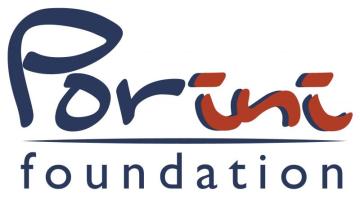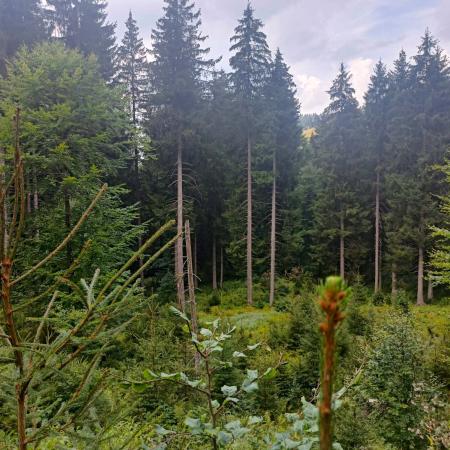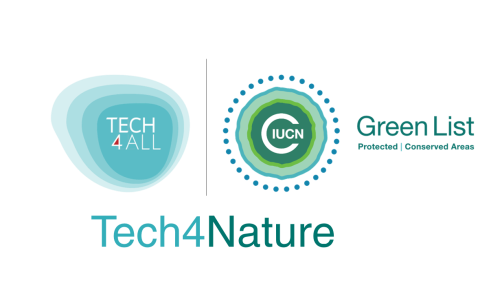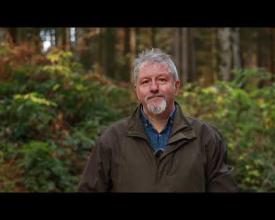

Biodiversity actions can create carbon sinks which and open up a way to bring these CO2 Certificates onto market. In this Tech4Nature pilot study, we calculated the amount of CO2 sequestered through management activities for Capercaillie (an endangered bird species in Switzerland) in the Schwägalp - Bruggerwald forest reserve.
The goal of this pilot study is to test the assumptions made in the newly developed Green List Standard for Carbon (GLS+). GLS+ is an independent Standard but 60% of the indicators are based on the existing IUCN Green List Standard for protected and conserved areas to achieve effective, equitable, and successful conservation outcomes.
The Tech4Nature Pilot is run on real data generated through a biodiversity intervention in the year 2021 to favor the locally endangered Western Capercaillie (Tetrao urogallus) but was only testing the potential for CO2 certificates without creating them.
Context
Challenges addressed
- Conservation of the Capercaillie: Creating a suitable habitat for the conservation of the Capercaillie, a locally endangered bird species. This involves
- Biodiversity enhancement through sustainable wood extraction: Opening up the dense forest to create an appropriate ecosystem for the Capercaillie and enhance overall biodiversity within the reserve while benefitting the forester by using the extracted wood in long-terme structures. Thus, binding the CO2 over time, necessary for the creation of CO2 certificates
- Avoiding previous logging and land conversion: The area must meet the additional requirement of not having been previously logged for carbon credit generation or undergone conversion from its original forested state.
- C02 sequestration and baseline estimation: Accurately calculating CO2 sequestration by establishing a baseline without any intervention and identifying the gap between this baseline and the expected outcomes through the implemented measures.
Location
Process
Summary of the process
In order to be able to isssue CO2 certificates for a certain project, all building blocks must be achieved.
Building Blocks
Additionality
In carbon offset projects, additionality is crucial for determining the quality of carbon offset credits. A project is said to be "additional" if its associated greenhouse gas (GHG) reductions would not have occurred without the specific intervention, thereby ensuring the credibility and effectiveness of the carbon credits issued.
Enabling factors
Additionality is respected if the cut would not have been done without the financial contribution of the issued CO2 certificates.
Lesson learned
As the cut was already executed and the calculation was done retrospective, this condition was not respected in the examined Pilot project. But if the cut is done for biodiversity reasons and the resulting CO2 certificates are used to finance the cut or increase the managed surface, then this condition would be respected.
Avoid double counting
Double counting in carbon projects refers to a situation where a carbon credit is claimed by more than one entity, without producing any additional carbon benefit. In simple terms, it occurs when two parties claim the same carbon removal or emission reduction benefits. Double counting undermines the integrity of carbon offset programs and the fight against climate change as it distorts the actual emissions reductions or removals achieved. It essentially dilutes the value and effectiveness of carbon credits.
Enabling factors
Double counting can be avoided if all work is done through one entity and announced to one standard method like the GLS+ methodology tested in this pilot project.
Lesson learned
In the actual setting with one entity and a specific forest, where no measures other then biodiversity measures can be legally undertaken, double counting was not a major concern.
Long-term sequestration
Long-term sequestration refers to the practice of capturing, securing, and storing greenhouse gas (GHG) or other forms of carbon from the atmosphere for an extended period of time, ideally indefinitely.
The goal of long-term sequestration is to mitigate the effects of climate change by reducing the levels of CO2 and other greenhouse gases in the atmosphere.
Enabling factors
It is important that the used methods are sustainable and secure to ensure that the carbon does not re-enter the atmosphere. In this pilot, we reached that goal through using the wood for construction purposes in the area near the forest reserve.
Lesson learned
Long-term sequestration is essential for stabilizing global carbon levels and is considered a crucial component in efforts to combat climate change, but to identify and secure the long term storage of CO2 in construction sites is a large task and costly exercise.
Baseline
The baseline refers to the projection of greenhouse gas (GHG) emissions that would occur in a specific project area if no interventions or changes to current practices are implemented. This serves as a point of comparison to assess the effectiveness of the carbon project in reducing emissions.
Enabling factors
The baseline is essential for calculating the actual carbon reductions attributable to the Capercaillie project and to measure the project’s impact on mitigating climate change.
Lesson learned
The baseline sets the benchmark for assessing the carbon reduction achievements of the project and is therefore highly relevant for the issuance of CO2 certificates. Especially demanding is the forecast of the developement in a given area over long periods of time, which plays a crucial role on the amount of CO2 certificates issued. The long term protection goal in protected and conserved area is therefore a important advantage for the long term sequestration of CO2 equivalents.
Impacts
60% of the requirements for the Green List Standard (GLS) are also necessary for the tested GLS+ Standard. Starting the GLS+ process for carbon could therefore lead the path to the GLS certification and vice versa.
GLS+ is adding the possibility to create high quality carbon credits and the new funds generated can be used to help finance protected and conserved areas to improve their governance and management performance and facilitate their journey towards IUCN Green List certification.
The estimated sequestered amount of 42.08 (tC/ha) and the value represented of approx. 1’000 USD/ ha, does not cover the deficit/ ha for the intervention in our Swiss Pilot project, but the additional funding will allow the extension of the treated area in favour of the Capercaillie.
This model could be attractive to implement in other parts of the world, with lower management cost and where this additional stream could help fill in existing funding gaps.
The managed area has been improved for the Capercaillie and at the same time a part of the costs can be covered throuh the GLS+ process generating CO2 certificates.
Beneficiaries
- The forest reserve
- Foresters
- The key species
- Community of Urnäch
- Potential investors
Sustainable Development Goals
Story

Swiss managed forest have become overmature as logging and managing these areas include important financial efforts. As a result, many forests have become dense and to dark to be suitable habitat for typical species like the Western Capercaillie (Tetrao urogallus), which has since become a rare species in the Swiss Alps. Opening up the forests quickly improves the habitat for these species but logging in these difficult conditions is a costly exercise. In order to increase the surface managed in favour for Capercaillie, we examined the possibilities and conditions to be met in order to co-finance such habitat intervention through CO2 certificates.
As a part of the Tech4Nature Initiative, a partnership agreement between Huawei and IUCN, we examined an old cut from 2021, where all information are now readily available, to estimate the expected CO2 equivalents for a new cut. By respecting the necessary conditions like additionality, double-counting, long-term sequestration and the business as usual base-line, we have been able to demonstrate that biodiversity measures do generate CO2 certificates which can be sold on the voluntary carbon market. We used different models, satellite pictures as well as Lidar and GIS to calculate different scenarios and estimated a mean equivalent of 42 CO2 tons per hectare sequestered through the opening up of the forests. This represents around 1000 USD/ ha which is a important contribution to reduce the costs for biodiversity measures in these step mountainous areas.


